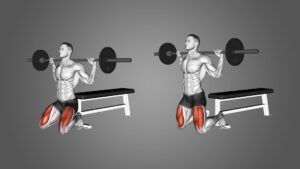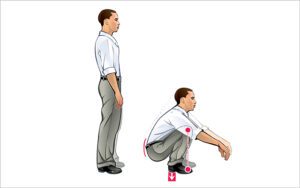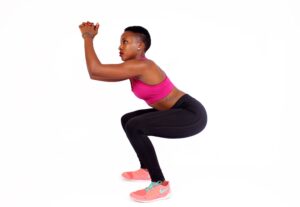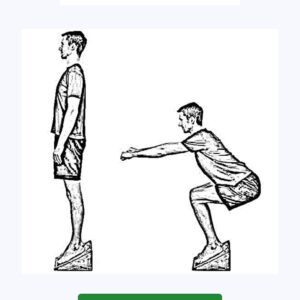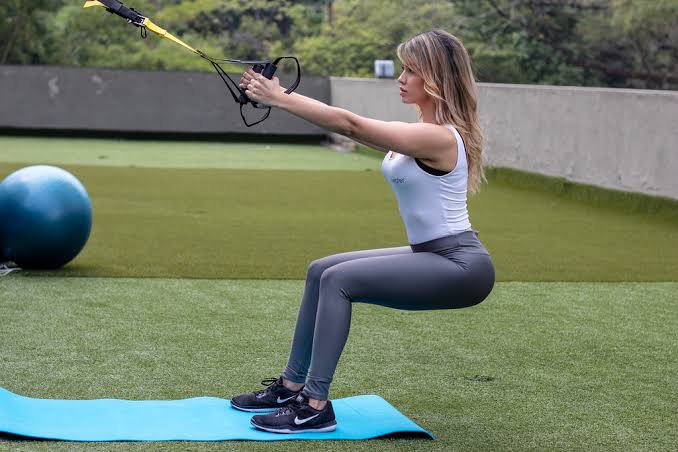
Cable squats are a fantastic exercise that targets multiple muscle groups in your lower body, making them a valuable addition to any workout routine.
By using a cable machine instead of traditional free weights, cable squats offer unique benefits that can help take your leg training to the next level.
In this article, we will explore ten incredible benefits of cable squats and why you should consider incorporating them into your fitness regimen.
Benefits of Cable Squats
Cable squats provides many benefits when done regularly and with proper form. Here are 10 incredible benefits of incorporating cable squats into your routine:
1. Increased Stability and Balance
One of the primary benefits of cable squats is the constant tension provided by the cable machine. This tension forces you to engage your core muscles and maintain stability throughout the movement.
By doing cable squats regularly, you can improve your balance and enhance overall stability, which is crucial for everyday activities and sports performance.
2. Greater Range of Motion
With cable squats, you can achieve a greater range of motion compared to traditional squats. The cable machine allows you to move in various planes, providing a more comprehensive workout for your lower body.
This increased range of motion can help improve your flexibility, joint mobility, and overall functional movement patterns.
3. Targeted Muscle Activation


Cable squats engage multiple muscle groups simultaneously, including your quadriceps, hamstrings, glutes, and calves.
The constant tension from the cable machine ensures that these muscles are constantly activated throughout the exercise. This targeted muscle activation can lead to greater strength gains and muscle development in your lower body.
4. Improved Glute Activation
If you’re looking to strengthen and shape your glutes, cable squats are an excellent choice.
The cable machine allows for a more pronounced hip extension at the top of the movement, resulting in enhanced glute activation.
This can help you build stronger and more aesthetically pleasing glute muscles.
5. Reduced Spinal Compression
Unlike traditional barbell squats, cable squats place less stress on your spine and joints. The cable machine provides a smooth and controlled resistance, minimizing the compressive forces experienced by your spine.
This makes cable squats a great alternative for individuals with back or joint issues, allowing them to perform squats with less risk of injury.
6. Enhanced Core Strength
Cable squats require significant core engagement to maintain stability throughout the exercise. Your core muscles, including your abdominals, obliques, and lower back, work together to stabilize your body and resist the pull of the cable.
Regularly performing cable squats can help strengthen your core muscles, leading to improved posture and overall functional strength.
7. Versatility and Variety
Cable squat machines typically come with various attachments, allowing for a wide range of exercise variations.
You can perform narrow stance squats, sumo squats, or even single-leg cable squats, targeting different muscle groups and adding variety to your training routine. This versatility keeps your workouts interesting and prevents plateaus in your progress.
8. Increased Proprioception
Proprioception refers to your body’s ability to perceive its position in space. Cable squats challenge your balance and coordination, forcing you to develop better proprioceptive awareness.
This heightened sense of body awareness can carry over into other exercises and daily activities, reducing the risk of falls and improving overall movement efficiency.
9. Injury Prevention
Strengthening the muscles around your joints is crucial for injury prevention. Cable squats engage multiple muscle groups, including your quadriceps, hamstrings, and glutes, which are essential for maintaining joint stability.
By regularly performing cable squats, you can strengthen these muscles, reducing the risk of injuries, particularly in the knees and hips.


10. Time Efficiency
Cable squats offer a time-efficient workout option. Since the cable machine provides constant resistance, you can effectively work your lower body muscles without the need for heavyweights or additional equipment. This makes cable squats a great choice for individuals with limited time or access to a fully equipped gym.
Cable squats offer numerous benefits that can elevate your lower body training. From increased stability and balance to targeted muscle activation and injury prevention, incorporating cable squats into your fitness routine can yield impressive results.
Additional Cable Squat Benefits
Here are some additional potential benefits of cable squats:


- Functional Strength: Cable squats mimic real-life movements, such as bending down, lifting objects, or getting up from a seated position. By training these functional movements, you can improve your overall strength and make everyday tasks easier.
- Core Stability: Cable squats require your core muscles to work hard to maintain stability and resist the pull of the cable. This helps strengthen your core, including your deep stabilizing muscles, leading to better posture and reduced risk of lower back pain.
- Improved Joint Health: Cable squats provide a controlled and smooth resistance throughout the movement, reducing the impact on your joints. This makes them a suitable option for individuals with joint issues or those recovering from injuries.
- Increased Calorie Burn: Cable squats engage multiple muscle groups and elevate your heart rate, resulting in an increased calorie burn during and after the exercise. This can be beneficial for weight loss or maintaining a healthy body composition.
- Versatile Training Options: Beyond squats, cable machines offer a wide range of exercise possibilities. You can perform lunges, step-ups, rows, and various other exercises to target different muscle groups and add diversity to your workouts.
- Improved Posture: Cable squats require proper alignment and engagement of your postural muscles, including your back, shoulders, and core. Regularly incorporating cable squats into your routine can help correct imbalances, improve posture, and reduce the risk of postural-related issues.
- Mental Focus and Mind-Muscle Connection: Cable squats require concentration and focus to maintain stability and execute the movement correctly. This helps develop a strong mind-muscle connection, which can enhance your overall training experience and optimize muscle activation.
- Increased Resistance and Challenge: The primary advantage of cable squats is the added resistance provided by the cable machine. Unlike traditional squats, the cable attachment allows for continuous tension throughout the movement, challenging your muscles and promoting greater strength gains.
- Added Stability for Beginners: for beginners or individuals with stability concerns, cable squats can be a helpful tool. The cable attachment provides stability and support, making it easier to maintain proper form and gradually build strength without sacrificing balance.
Remember to always prioritize proper form and technique when performing cable squats or any other exercise. If you’re new to cable squats or have any concerns, consider working with a qualified fitness professional to ensure you’re performing the exercise correctly and safely.
How to do Cable Squats Correctly and Reap It’s Benefits
To reap the maximum benefits of cable squats, it’s crucial to perform them with proper form. Here’s a step-by-step guide to help you execute cable squats correctly:
- Set up the Cable Machine: Adjust the cable machine to a height that allows the cable to be slightly above your shoulders. Attach the appropriate handle or rope attachment.
- Stand Facing the Cable Machine: Position yourself in front of the cable machine, facing away from the machine, with your feet shoulder-width apart. Hold the handle or rope attachment with both hands, palms facing each other.
- Engage Your Core: Before starting the squat, engage your core muscles by drawing your navel towards your spine. This will help stabilize your torso throughout the movement.
- Begin the Squat: Initiate the squat by pushing your hips back and bending your knees. Imagine sitting back into an imaginary chair. Keep your chest lifted, back straight, and knees tracking over your toes.
- Lower Down: Continue descending until your thighs are parallel to the floor or as low as you can comfortably go while maintaining proper form. Ensure that your knees are in line with your toes and not collapsing inward.
- Drive through the Heels: As you reach the bottom of the squat, exhale and push through your heels to return to the starting position. Focus on engaging your glutes and thighs to power the upward movement.
- Maintain Control: Throughout the entire exercise, maintain control and avoid any jerky or sudden movements. Keep the tension on the cable, feeling the resistance as you squat down and stand back up.
- Repeat: Perform the desired number of repetitions, aiming for a controlled and steady pace. Start with a weight that challenges you but allows you to maintain proper form. Gradually increase the weight as you become more comfortable and stronger.
Additional tips to maximize the benefits of cable squats:
- Keep your chest lifted and shoulders relaxed throughout the movement.
- Avoid rounding your back or allowing your knees to cave inwards.
- Focus on the mind-muscle connection, actively engaging your glutes and thighs.
- Breathe steadily, inhaling as you lower into the squat and exhaling as you push back up.
- Gradually increase the weight as you progress to continue challenging your muscles.
It’s essential to start with a weight that allows you to maintain proper form. As you become more comfortable and stronger, gradually increase the weight to continue challenging your muscles.
By following these steps and paying attention to proper form, you can maximize the benefits of cable squats. Incorporate cable squats today into your lower body workout routine for a challenging and effective exercise option.
Related Posts
Reference:
- How To Do Cable Squats (Form & Benefits) – Steel Supplements
- Cable Squats : Everything You Need To Know Before You Start Doing It
- Cable squats:Tips and benefits of Cable Squats – QueryExpress
- 4 Cable Machine Exercises For Stronger Legs – Muscle & Fitness
- Cable Squats – Benefits and How to Do at Home – Trendingbird



